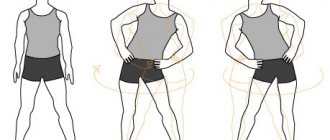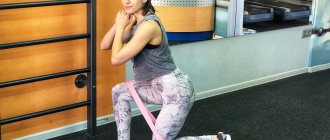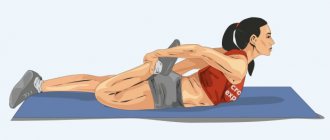The need for exercise before training
Stretching the muscles before training, especially after a night's sleep, is extremely necessary, as it allows you to:
- stretch muscles that are tight and the joints themselves are inactive;
- prepare the body for more serious physical exercise (without it, you can quickly sprain ligaments or get other injuries);
- ensuring a normal level of metabolism, which is very important during the training phase.
To ensure that warm-up and stretching before training are done correctly, allocate 15-20 minutes to this process. The first 10 minutes should be aimed at warming up the muscles.
It is recommended to start any muscle training with a warm-up.
To do this, you should perform the following exercises:
- A short jog.
- Squats that do not use weights.
- Warm-up with a skipping rope.
- Bench press.
After doing the warm-up exercises, you can proceed directly to muscle stretching. Please note that the warm-up should not replace the main training time.
Benefits of stretching and warming up muscles
Improves productivity
By far, the best benefit of stretching or warming up your muscles is how it affects your performance. It helps improve in three effective ways:
- Improves Circulation – Warming up or stretching for 10 minutes improves circulation and opens blood capillaries, which has been linked to improved subsequent physical performance.
- Improves oxygen function - oxygen is released into muscles faster at higher temperatures. If you stretch before your workout, you'll warm up your muscles, which will be ready for peak performance during your workout. If you skip stretching, oxygen can be released into the muscles during exercise over a long period of time, which can negatively impact your performance.
- Accelerates muscle contractions – warming up the muscles before exercise increases body temperature. This leads to better nerve transmission and muscle metabolism. As a result, your muscles will respond faster and more effectively to all stimuli during and after training. [5] [6] [7]
Serves as injury prevention
With an effective and consistent pre-workout warm-up, you relax your joints, increase joint range, and improve blood flow to your muscles . All of these aspects are extremely important in preventing injury . The stiffer and more bloodless your muscles are, the higher your risk of injury during exercise. [5] [6] [7]
Removes heat from the body
Activation of the body's heat removal mechanisms promotes effective muscle cooling , which helps prevent overheating and subsequent overtraining. This benefit is especially important during intense aerobic activity such as running or cycling. [5] [6] [7]
Balances hormone production
During physical activity, the body increases the production of various hormones , including cortisol and adrenaline . They are directly responsible for regulating energy production and your physical performance. If you skip your pre-workout warm-up, these hormones may activate late and have no effect. On the contrary, you can activate them already during the warm-up , which will give your body enough energy during training. [16] You can read about the effect of hormones on the growth and regeneration of muscle mass in our article. How does hormonal imbalance affect muscle mass in men and women?
Types of stretch marks
Stretching before strength training is an important element for every athlete, and it can be:
Dynamic
Dynamic stretching involves performing exercises in a constant manner without reducing speed. Due to the fact that the same rather short elements will be repeated many times, the amplitude will increase.
Static
The peculiarity of static stretching is that the adopted pose must be held for about 30 seconds, followed by increasing the stretch of the trained muscles to the maximum value. After 30–60 seconds after performing static stretching, complete muscle relaxation occurs.
Remember that the purpose of stretching before training is not to increase your flexibility and plasticity, but to prevent muscle injuries and prepare the whole body for work
Note! When performing both dynamic and static exercises, a person should not feel pain, and all movements should only be done smoothly and slowly, gradually increasing the amplitude.
Warm-up at home: types of exercises
Warming up before training at home, a video for women of which will help you understand more about it, should be comprehensive. As already mentioned, it includes three components. Let's take a closer look at them.
General warm-up
Warm-up exercises before training at home for girls can be divided into groups:
- Universal . They can be used before any type of physical activity. Such exercises are general complexes that are familiar to us from school. This can be turns and tilts of the head, and after them - working on the shoulders, arms, body, hips, shins, and ankles. You can complete this with breathing exercises. You can watch a video of a full body warm-up at home to learn more about it.
- Special . The difference between them is that they are aimed at maximally warming up the specific muscle groups that you are going to work. If we are talking about strength training, then exercises from the standard complex can be performed, but without the use of additional weights.
You can use the same running, jumping rope, fast walking, going up and down the stairs. A good warm-up for the abs is spinning a hoop. If you plan to run, you can do lunges, squats, bends, and push-ups. Stretch your thighs and calves. Rotation of the knee joints and ankles is also important.
Warm up the joints
A video warm-up before training at home, aimed at the joints, helps improve their mobility and coordination. Such a complex can be quite effective, and even replace a full-fledged workout. It is recommended to perform it both before cardio training and before strength exercises, fitness, yoga, and so on. In this case, the complex may consist of the following exercises:
- Tilt your head to the sides and forward and back, rotate your head.
- Tilts the body to the sides.
- Stretch your arms out to the sides and up.
- Rotations of the hands, chest, shoulders and forearms.
- Pelvic rotations, body twists, leg rotations.
- Raising the legs, bending and extending them at the knees.
- Rotation of the ankle joints.
- Calf raises.
Warm-up
To lose weight and/or improve your body shape, you need to approach this issue comprehensively. Not the least place in this case is given to stretching. It is often recommended as a cool-down after a workout, but before physical activity it will not be superfluous. It is recommended to perform exercises with a certain amplitude.
The better the muscle tissue is warmed up and stretched, the lower the risk of injury.
It is recommended to do stretching after a mini-set of warm-up movements. Everything needs to be done smoothly and carefully, avoiding pain. You should feel comfortable. If the stretching was done correctly, a pleasant feeling of warmth should spread throughout the body. Stretching is especially important for those who want to do the splits. When the muscles warm up a little, you can begin a dynamic warm-up. Warm-up exercises before training at home for girls can be as follows:
- As a basis, you can take exercises aimed at general warming up. When performing them, try to linger for a while at the top point and stretch the muscles as much as possible.
- If necessary, help yourself with your hands, but try to avoid jerking. Please note that when practicing on your own, you may have difficulty assessing the correctness of your body position and your progress. If possible, do exercises in front of a mirror. This will give you the opportunity to see your main mistakes and, if necessary, correct them immediately.
- Exercises such as swings, rotations with legs and arms, and various lunges are good for warming up. Please note that the amplitude should initially be small and increase over time.
Features of dynamic stretching
Dynamic stretching can be the most necessary element, carried out during the warm-up period. Its features include:
- the ability to keep the body warm throughout the entire workout;
- Stretching exercises before training will help increase the body's performance;
- the muscle tension created by dynamic stretching will help runners quickly gain speed, and bodybuilders will increase their sense of balance;
- when performing a dynamic warm-up, it is important to repeat all exercises approximately 5-6 times with a delay of no more than 5 seconds;
- the key role should be given to those exercises that will create an imitation of real training elements.
When dynamic stretching is performed correctly, many problems with a person’s physical health can be avoided.
What to include in dynamic stretching?
Warm up well before stretching. Very good. Muscles need to be “hot”
A set of exercises that are advisable to perform during dynamic stretching include:
- For the neck: bending and turning the head; smooth rotation in a circle.
- For the chest and back: stretching your arms, fastened in a lock in front of you, with your back forward and smoothly moving them in the opposite direction.
- For shoulders: swing your arms; circular movements and raising the shoulders up and down.
- For the body: rotational movement of the pelvis; turns the waist and bends in different directions.
- For the arms: performing circular movements in both the elbow and shoulder joints.
- For legs: tilt towards the feet; circular movements of the knees and feet; lunges forward and to the sides.
This set of exercises will be enough to perform high-quality dynamic stretching.
Muscle stretching before exercise
Before exercise, dynamic stretching can be part of your warm-up. The simplest rotations of the shoulders, arms, bends forward and to the sides, lunges - all these exercises are dynamic stretching.
If you want to take care of your shoulder joints and muscles, you can do stretching according to the video:
video - stretching to prevent shoulder injury video - stretching to prevent shoulder injury video - stretching to prevent shoulder injury
For the muscles of the legs and back, you can do the following dynamic stretching:
video - stretching and warming up the legs and back before strength training, Dmitry Klokov
Great stretch before squats
video - stretching and warming up the legs and back before strength training
If you do exercises to stretch the leg muscles before Squats with a barbell on your shoulders, you can significantly increase the range of motion (you will squat deeper) and reduce the risk of injury.
Features of static stretching
In those moments when you experience slight hitches, it is advisable to move on to static stretching. Features:
- When performing static stretching, you need to pay attention to those muscle groups that the exercises are aimed at;
- the duration of one exercise can be about 30 seconds, but no more;
- when performing static stretching, you should not feel pain, but, on the contrary, a pleasant feeling of stretching;
- to get the best results, all exercises should be carried out calmly, while breathing deeply and measuredly;
- For maximum muscle stretching, the place where static stretching will occur must be warm.
The main task is to prepare the muscles for the load. First warm up, then strengthen the plasticity for the duration of the workout by stretching
Static stretching exercises allow muscles to recover much faster and relieve tension. There is immediate removal of decomposition products.
By adhering to a whole range of prescriptions, static exercises will help you achieve the best results.
What exercises are suitable for an ideal warm-up?
If you need to stretch before training at home, then you can use a fairly simple set of exercises:
- Bend forward.
- Raising your knees.
- Lateral bends.
- Rotational movements of the arms.
- Raising the body.
- Exercise "Boat".
- Raising the legs and abducting them.
- Pushups.
- Cardio exercises.
This is an example set of exercises that can be used to stretch before a serious workout.
Stretching before exercise has two purposes: injury prevention and proper form.
Pre-workout warm-up program
Let's look at what a proper warm-up before a workout should look like. In different sports, the set of exercises or sequence of movements may change, but the basic principles remain the same. In the absence of specialized conditions, warm-up is performed for the whole body (from top to bottom) or only for the muscles involved in the work. For example, when training the chest, this would be abductions/reductions of the arms, raises of the arms and flexion at the elbow for the triceps.
Example of a warm-up program
- Swing your arms back and forth;
- Rotational movements with elbows bent back and forth;
- Rotation of the hands;
- Rotate your head left and right;
- Circular rotation of the pelvis to the right and left;
- Body rotations;
- Rotational movements in the knees in both directions;
- 10 bodyweight squats;
- Calf raises.
Warm-up before training / Yaroslav Brin.











